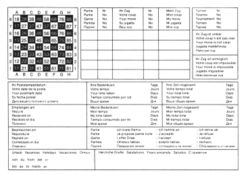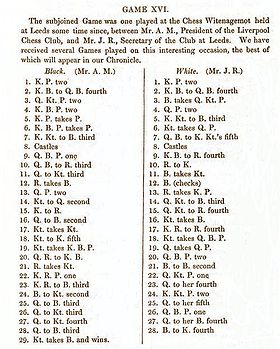
- Chess World Cup
- FIDE Grand Prix
- Olympiad
- World Championship
- List of strong tournaments
- List of world championships

- Checkmate patterns
- Chess openings
- Chess strategy
- Chess tactics
- Chess theory
- Endgames
- Pawn structure
- Problems/Compositions












Chess notation is the term for several systems that have developed to record either the moves made in a game of chess or the position of pieces on a chessboard. The earliest systems of notation used lengthy narratives to describe each move; these gradually evolved into terser notation systems. Currently algebraic chess notation is the accepted standard and is widely used. Algebraic notation has several variations. Descriptive chess notation was used in English- and Spanish-language literature until the late 20th century, but is now obsolete. There are some special systems for international correspondence chess. Portable Game Notation is used when working with computer chess programs. Systems also exist for transmission using Morse code over telegraph or radio.
Some move-recording notations are designed mainly for use by human players; others are designed for use by computers.
 Correspondence chess card showing algebraic notation and ICCF notation
Correspondence chess card showing algebraic notation and ICCF notationIn recognized competitions, all players are required to record all the moves of both players in order to resolve disputes about whether a player has made an illegal move and what the position should now be. In addition, if there is a time limit rule that requires each player to complete a specified number of moves in a specified time, as there is in most serious competition, an accurate count of the moves must be kept. All chess coaches strongly recommend the recording of one's games so that one can look for improvements in one's play. The algebraic and descriptive notations are also used in books about chess.
Here is an example of the same moves in some of the notations which may be used by humans:
| # | Algebraic | Figurine algebraic | Long algebraic | Reversible algebraic | Concise reversible | Smith | Descriptive | Coordinate | ICCF |
|---|---|---|---|---|---|---|---|---|---|
| 1. | e4 e5 | e4 e5 | e2-e4 e7-e5 | e2-e4 e7-e5 | e24 e75 | e2e4 e7e5 | P-K4 P-K4 | E2-E4 E7-E5 | 5254 5755 |
| 2. | Nf3 Nc6 | ♘f3 ♞c6 | Ng1-f3 Nb8-c6 | Ng1-f3 Nb8-c6 | Ng1f3 Nb8c6 | g1f3 b8c6 | N-KB3 N-QB3 | G1-F3 B8-C6 | 7163 2836 |
| 3. | Bb5 a6 | ♗b5 a6 | Bf1-b5 a7-a6 | Bf1-b5 a7-a6 | Bf1b5 a76 | f1b5 a7a6 | B-N5 P-QR3 | F1-B5 A7-A6 | 6125 1716 |
| 4. | Bxc6 dxc6 | ♗xc6 dxc6 | Bb5xc6 d7xc6 | Bb5xNc6 d7xBc6 | Bb5:Nc6 d7:Bc6 | b5c6n d7c6b | BxN QPxB | B5-C6 D7-C6 | 2536 4736 |
| 5. | d3 Bb4+ | d3 ♝b4+ | d2-d3 Bf8-b4+ | d2-d3 Bf8-b4+ | d23 Bf8b4+ | d2d3 f8b4 | P-Q3 B-N5ch | D2-D3 F8-B4 | 4243 6824 |
| 6. | Nc3 Nf6 | ♘c3 ♞f6 | Nb1-c3 Ng8-f6 | Nb1-c3 Ng8-f6 | Nb1c3 Ng8f6 | b1c3 g8f6 | N-B3 N-B3 | B1-C3 G8-F6 | 2133 7866 |
| 7. | 0-0 Bxc3 | 0-0 ♝xc3 | 0-0 Bb4xc3 | 0-0 Bb4xNc3 | 0-0 Bb4:Nc3 | e1g1c b4c3n | 0-0 BxN | E1-G1 B4-C3 | 5171 2433 |
In all forms of notation, the result is usually indicated at the conclusion of the game by either a "1-0", indicating that white won, a "0-1" indicating that black won or a "½-½", indicating a draw.
Annotators commenting on a game frequently use question marks ("?") and exclamation marks ("!") to label a move as bad or praise the move as a good one (see Chess annotation symbols).
The following are commonly used for chess-related computer systems (in addition to Coordinate and Smith notation, which are described above):
Some special methods of notation were used for transmitting moves by telegraph or radio, usually using Morse Code. The Uedemann code and Gringmuth notation worked by using a two-letter label for each square and transmitting four letters - two letters for the origin square followed by two letters for the destination square. Castling is shown as a king move. Squares are designated from White's side of the board, files from left to right and ranks from nearest to farthest. The Rutherford code first converted the move into a number and then converted the move number into a composite Latin word. It could also transmit moves of two games at the same time.
This code was devised by Louis Uedemann (1854-1912). The method was never actually used, mainly because a transposition of letters can result in a valid but incorrect move. Many sources incorrectly use this name for the Gringmuth code.
The files are labeled "A", "E", "I", "O", "O", "I", "E", and "A". The ranks are labeled "B", "D", "F", "G", "H", "K", "L", and "P". A square on the queenside is designated by its file letter and then its rank letter. A square on the kingside is designated by its rank letter then its file letter.
This method was invented by D.A. Gringmuth but it is sometimes incorrectly called the Uedemann Code. It was used as early as 1866. Files were designated with one of two letters, depending on whether it was on White's side or Black's side. These letters were: B and M, C and N, D and P, F and R, G and S, H and T, K and W, L and Z. Ranks were labeled: "A", "E", "I", "O", "O", "I", "E", and "A".
This code was invented in 1880 by Sir William Watson Rutherford (1853-1927). At the time, the British Post Office did not allow digits or ciphers in telegrams, but they did allow Latin words. This method also allowed moves for two games to be transmitted at the same time. In this method, the legal moves in the position were counted using a system until the move being made was reached. This was done for both games. The move number of the first game was multiplied by 60 and added to the move number of the second game. Leading zeros were added as necessary to give a four-digit number. The first two digits would be 00 through 39, which corresponded to a table of 40 Latin roots. The third digit corresponded to a list of 10 Latin prefixes and the last digit corresponded to a list of 10 Latin suffixes. The resulting word was transmitted.
After rules were changed so that ciphers were allowed in telegrams, this system was replaced by the Gringmuth Notation.
  |
King |
|---|---|
  |
Queen |
  |
Rook |
  |
Bishop |
  |
Knight |
  |
Pawn |
Positions are usually shown as diagrams (images), using the symbols shown here for the pieces.
There is also a notation for recording positions in text format, called the Forsyth-Edwards notation (FEN). This is useful for adjourning a game to resume later or for conveying chess problem positions without a diagram. A position can also be recorded by listing the pieces and the squares they reside on, for example: White: Ke1, Rd3, etc.
There are also systems for classifying types of endgames.
 Page from 1841 Chess Player's Chronicle
Page from 1841 Chess Player's ChronicleThe notation for chess moves evolved slowly, as these examples show. The last is in algebraic chess notation; the others show the evolution of descriptive chess notation and use spelling and notation of the period.
A text from Shakespeare's time uses complete sentences to describe moves, for example, "Then the black king for his second draught brings forth his queene, and placest her in the third house, in front of his bishop's pawne" - which we would now write as 2 ... Qf6. The great 18th-century player Philidor used an almost equally verbose approach in his influential book "Analyse du jeu des Échecs", for example, "The king's bishop, at his queen bishop's fourth square."
Algebraic chess notation was first used by Philipp Stamma (c. 1705-55) in an almost fully developed form before the now obsolete descriptive chess notation evolved. The main difference between Stamma's system and the modern system is that Stamma used "p" for pawn moves and the original file of the piece ("a" through "h") instead of the initial letter of the piece. In London in 1747, Philidor convincingly defeated Stamma in a match. Consequently, his writings (which were translated into English) became more influential than Stamma's in the English-speaking chess world; this may have led to the adoption of a descriptive system for writing chess moves, rather than Stamma's coordinate-based approach. However, algebraic notation became popular in Europe following its adoption by the highly influential Handbuch des Schachspiels, and became dominant in Europe during the 20th century. However, it did not become popular in the English-speaking countries until the 1970s.